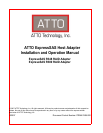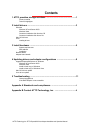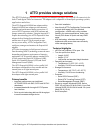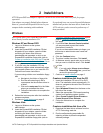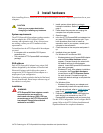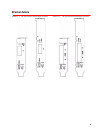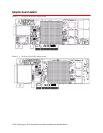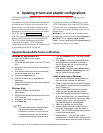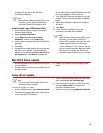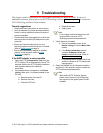
4
3 Navigate to the expanded software package
folder.
4 The ExpressSAS Windows driver is located in
the base directory. The x86 package also
includes a Storport directory. Navigate to the
folder with the desired ExpressSAS driver.
5Run makedisk.exe.
6 Follow the instructions to complete the
installation.
Mac OS X drivers
The ATTO ExpressSAS adapter supports Macintosh
operating systems: Mac OS X 10.4 or later
1 Power on your system.
2 Double click the supplied gzip file.
3A dmg is installed on the desktop. Mount the
dmg file.
4 Open the contents of the mounted file.
5 Double-click on the installer.
6 Follow the on-screen instructions
7 Reboot.
8 Continue to Install hardware
on page 5
Linux
The ATTO ExpressSAS adaptor supports Linux
operating systems RedHat ES 3, 4; Suse Linux 9, 9.1,
9.2, 9.3, 10, 10.1 and the following architectures: i386
(with or without CONFIG_REGPARM); x86_64
(AMD64, Intel EM64T).
Note
The ExpressSAS RAID adapters are not
supported under Linux 2.4.
1 Power on your system.
2 Unzip and untar the driver files:$ tar xfz
filename.tgz
3 Change to the extracted directory:$ cd
extracted_directory_name
Make sure there are no spaces in the path in
which you extract the archive. The Linux kernel
Makefile will fail if the path name contains a
space character.
Kernel header files must be installed to build this
driver. If the files are in a non-standard location,
modify the KDIR variable in the Makefile.
4 As root, make and install the modules:$ make
install
5 The modules are ready to use. If drivers load
automatically, continue to Install hardware
on
page 5. Otherwise, refer to Loading drivers
on
this page.
Loading drivers
• To load a driver manually, type $ modprobe
esasraid
You may receive a warning that the module will
taint the kernel.
• Red Hat Hardware Discovery Utility may ask you
to Configure the Device, Ignore, or Do
Nothing after loading the driver for the first time.
Select Configure and follow the utility’s
configuration prompts.
• To load a driver at boot if your system does not
do so automatically:
• Red Hat 4. Add the following line to
/etc/modprobe.conf after installing the
driver: alias scsi_hostadapterX esasraid
where X is the next available number.
• Red Hat 3. Add the following line to /etc/rc.
modules after installing the driver
modprobe esasraid
You may need to create /etc/rc.modules
and make it executable with ‘chmod +x
/etc/rc.modules’
• SUSE 9
1 Run the yast utility by selecting it the GUI under
System in the application menu or running it
from a command line.
2Select Hardware
3Select Disk Controller
4 Under Disk Controller Configuration, select
the ATTO device.
5 Under the Module to Use heading, select the
esasraid module
6 In the box next to Load Module in initrd, put an
X
7Select Finish to complete the configuration.
• SUSE 10. Add the following line to
/etc/init.d/boot.local after installing the
driver: modprobe esasraid



